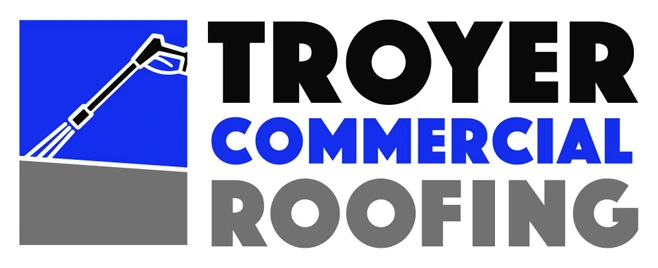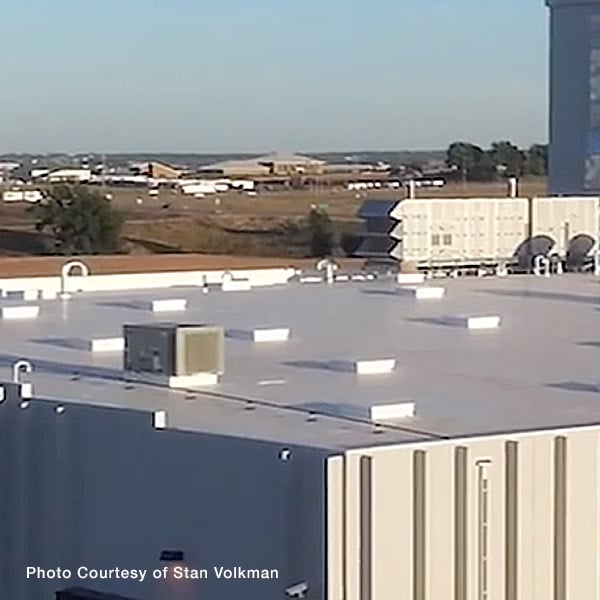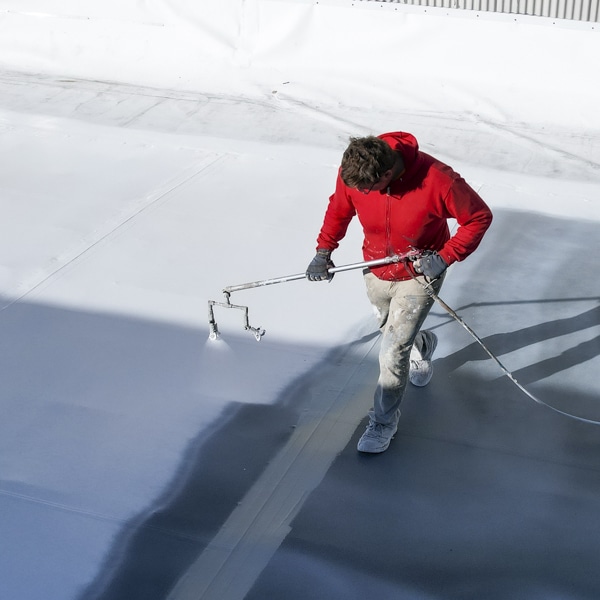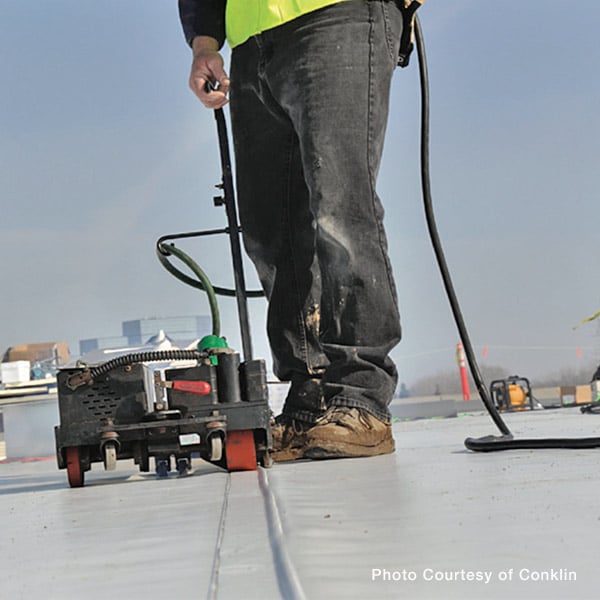Rubber Roof Repairs – Commercial Buildings
The EPDM product is one of the more common and inexpensive roofing systems for commercial buildings in Florida. Many business owners and facility managers may not realize that EPDM is a rubber roof. Ethylene propylene diene terpolymer or EPDM is a durable synthetic rubber membrane for flat or low-slope commercial roofs. Although an EPDM rubber roof has high impact resistance with a lifespan of up to 30 years or more, it is highly susceptible to damage in Florida’s challenging climate. This often leads to roof leaks, meaning rubber roof repairs are required or early replacement.
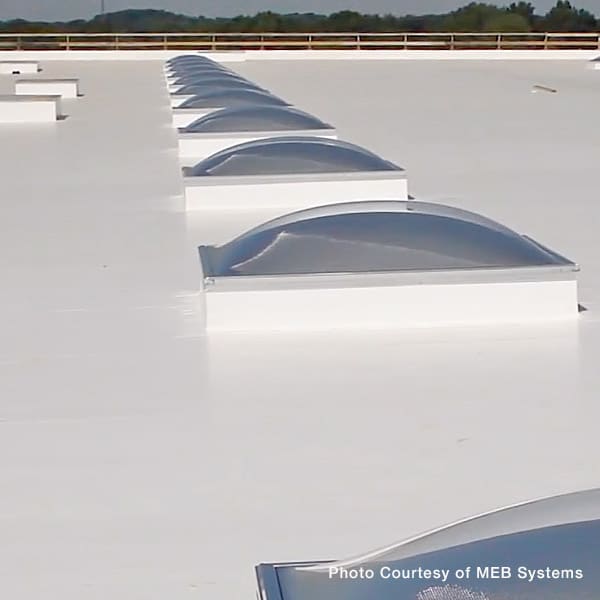 Weather and Environmental Impacts on Rubber Roofs
Weather and Environmental Impacts on Rubber Roofs
Weather and environmental conditions have a substantial impact on rubber roofs. When not protected with an acrylic elastomeric reflective coating, heat absorption from continuous exposure to the sun’s damaging UV rays can cause the rubber membrane to shrink, become brittle, and crack. This exposes the roofing system to water leaks when it rains. When rubber roof repairs are not done correctly, the entire roofing system can be compromised, resulting in a premature replacement.
Rubber Roof Coatings
Troyer Commercial Roofing is a certified Conklin Roofing Systems contractor specializing in EPDM rubber roof repairs in Southwest Florida for older or weathered agricultural, industrial, and commercial buildings. Our elastomeric roof repair coatings are a durable, cost-effective, and energy-efficient alternative to a rubber roof replacement.
Sustainable & Renewable Eliminates Future Roof Replacements
Conklin’s single-ply rubber membrane coatings are a sustainable and renewable solution for repairing, restoring, and protecting your existing EPDM rubber roof. The advanced system provides a robust waterproof barrier, eliminating potential leaks which lead to future roof replacements. A periodic re-coating will extend your rubber roof’s lifespan for decades. In addition, it can often be recoated multiple times for the entire duration of its useful life, allowing you to get the most out of your roof investment.
Benefits of Rubber Roof Repairs
Our white solar-reflective rubber roof coatings repair and preserve your existing rubber roof with a 100% seamless, walkable, water- and fire-resistant surface that is more cost-effective, durable, and energy-efficient than many other roofing materials. It also delivers additional outstanding benefits:
Fast Roof Leak Repair
Our elastomeric rubber roof coating covers the entire surface of your roof. This instantly fills any cracks, gaps, and repairs other deficiencies, providing leak-free protection for years.
Superior Weatherproof Barrier
A superior waterproof barrier protects your rubber roof membrane 24/7 from the damaging effects of rain, wind, and UV radiation.
Saves Energy Costs
Our rubber roof repair coatings are rated by EnergyStar and the Cool Roof Rating Council (CRRC). It reflects up to 85% of UV radiation, keeping the roof’s surface temperature up to 80°F cooler, substantially reducing energy costs.
Positive Return on Investment
Our rubber roof repairs can often pay for themselves in energy savings alone. In addition, your business may be eligible for tax credits, utility rebates, and other financial incentives. This will help you to recoup your investment sooner.
Extends Your Rubber Roofing System’s Lifespan
Our white reflective rubber roofing repair coatings are durable and cost-effective. The roof restoration solution adds decades to aging or weathered EPDM membranes. Plus, it has all the benefits of a “cool roof” for significantly less than the cost of a complete roof replacement.
Rubber Roof Repairs in Southwest Florida
Why replace when you can repair and preserve your rubber roof in Sarasota FL for less? For a limited time, Troyer Commercial Roofing is offering FREE roof inspections for agricultural, industrial, and commercial buildings in Bradenton, Fruitville, Longboat Key, Palmetto, and surrounding communities in Florida. Call to schedule an appointment for a free estimate today.
5 Maintenance Tips to Keep Your Rubber Roofing Healthy
1. Conduct Regular Inspections
Regular inspections are crucial for identifying early signs of damage to your rubber roofing. Look for visible cracks, punctures, or areas where the membrane may be lifting. Addressing minor issues early can prevent larger problems that require extensive rubber roof repair. It’s recommended you inspect your roof at least twice a year, particularly after severe weather events. Regular inspections ensure that your rubber roof remains in good condition and extends its lifespan.
2. Clean the Roof Surface
Keeping your rubber roofing free of debris is vital for preventing damage. Leaves, dirt, and other debris can accumulate, trapping moisture and causing the membrane to weaken. Use a soft broom or water hose to clean the roof’s surface regularly, ensuring no sharp objects or materials are present. A clean surface also makes it easier to spot any potential issues that may require rubber roof repair, helping you maintain the longevity and performance of your roof.
3. Check for Ponding Water
Ponding water is a common issue with flat rubber roofing systems, especially after heavy rain. Prolonged exposure to standing water can weaken the rubber membrane and lead to leaks. Make sure your roof has adequate drainage to prevent ponding, and if necessary, contact a professional for rubber roof repairs to correct any areas where water tends to accumulate. Addressing this issue early helps avoid more severe water damage and extends the life of your roofing system.
4. Ensure Proper Ventilation
Proper ventilation is critical for maintaining the durability of your rubber roofing. Inadequate ventilation can cause excess heat buildup, leading to premature aging of the rubber membrane. This can result in cracking, shrinking, or other damage that necessitates a rubber roof repair. Make sure your building has sufficient ventilation systems in place to allow air to circulate, reducing the risk of heat-related damage and preserving the longevity of your roof.
5. Trim Overhanging Branches
Overhanging tree branches can pose a serious threat to your rubber roofing. High winds or storms may cause branches to fall and puncture the membrane, leading to leaks and requiring rubber roof repair. Regularly trimming branches near your roof reduces the risk of punctures and debris buildup. Maintaining a clear roof area also makes it easier to perform inspections and ensures that your rubber roofing is protected from potential environmental hazards.
Top 8 FAQs About Rubber Roofing And Rubber Roof Repairs
1. What is rubber roofing?
Rubber roofing, also known as EPDM (ethylene propylene diene terpolymer), is a durable and cost-effective roofing material commonly used for flat or low-slope commercial buildings. It’s made from synthetic rubber, providing excellent weather resistance and flexibility. Rubber roofing is popular due to its affordability and lifespan of 30 years or more. However, like any roofing system, it may require occasional maintenance or rubber roof repairs to address minor issues such as cracks or punctures caused by environmental factors.
2. How long does rubber roofing last?
With proper care and maintenance, rubber roofing can last 30 years or more. Its long lifespan makes it a preferred choice for many commercial building owners. Regular inspections and prompt rubber roof repairs can extend its longevity by addressing potential damage early. Environmental factors such as extreme heat, UV exposure, and heavy rain in Florida can impact its durability, but periodic maintenance, including applying protective coatings, will keep the roof in good condition for decades.
3. What are the benefits of rubber roofing?
Rubber roofing offers several benefits, including durability, flexibility, and resistance to weather damage. It can withstand extreme temperatures and is less likely to crack under pressure compared to other roofing materials. Rubber roofing is also energy-efficient when coated with reflective coatings, which can lower cooling costs. Additionally, it’s relatively easy to maintain, with rubber roof repair solutions available to address small issues quickly. Its cost-effectiveness and eco-friendly nature make it an attractive option for commercial buildings.
4. How do I know if my rubber roof needs repair?
Common signs that you may need rubber roof repairs include visible cracks, punctures, shrinking, or areas where the membrane appears loose or damaged. Water stains inside the building or roof leaks are also indicators of potential issues with your rubber roofing. It’s important to schedule regular roof inspections to identify these problems early. If you notice any of these signs, contacting a roofing professional for prompt repairs will help prevent further damage and extend the life of your roof.
5. Can rubber roofing be repaired, or does it need to be replaced?
Rubber roofing can often be repaired instead of replaced, depending on the extent of the damage. Small cracks, punctures, or seam separations can usually be fixed with rubber roof repair methods, such as applying sealants or patching damaged areas. In cases where the roof is significantly aged or has widespread damage, a replacement may be necessary. However, many rubber roofs can be restored and extended with the application of elastomeric coatings, making replacement less frequent.
6. How does weather impact rubber roofing?
Florida’s climate, with intense sunlight, heat, and heavy rainfall, can take a toll on rubber roofing over time. Continuous UV exposure can cause the rubber membrane to shrink, crack, or become brittle, leading to leaks. Storms or high winds can also cause punctures. Regular maintenance, including protective coatings and prompt rubber roof repair, can mitigate the effects of extreme weather. Ensuring proper drainage and addressing issues like ponding water also helps protect rubber roofing from weather-related damage.
7. Is rubber roofing energy-efficient?
Yes, rubber roofing is energy-efficient, especially when paired with a reflective coating like acrylic elastomeric. These coatings reflect up to 85% of UV rays, keeping the roof cooler and reducing the need for air conditioning, which lowers energy bills. In addition to providing protection against sun damage, these coatings contribute to making rubber roofing a cost-effective and energy-saving option. If your roof needs rubber roof repair, adding a reflective coating during the repair process can further enhance its energy efficiency.
8. How often should I inspect my rubber roof?
It’s recommended to inspect your rubber roofing at least twice a year, ideally in the spring and fall. Additionally, it’s important to conduct inspections after any severe weather events, such as storms or hurricanes, to identify potential damage. Regular inspections can help spot minor issues before they escalate into larger problems, reducing the need for major rubber roof repair. During inspections, pay attention to cracks, punctures, pooling water, and loose seams, which are common signs of wear on rubber roofs.
Signs You Need Rubber Roof Repairs
1. Visible Cracks or Tears
Cracks or tears in the rubber membrane are clear signs that your rubber roofing needs repair. These can occur due to weathering, UV damage, or physical impacts from debris. If left untreated, cracks can expand, allowing water to penetrate the roofing system and cause leaks. Prompt rubber roof repair is essential to prevent further deterioration and water damage. Regular inspections can help catch these cracks early, allowing for repairs before they lead to more significant issues.
2. Pooling Water on the Roof
Ponding or pooling water on your rubber roofing is a red flag. Flat roofs can sometimes develop drainage issues, causing water to accumulate in low spots. Over time, standing water can weaken the rubber membrane, increasing the likelihood of leaks. If you notice consistent ponding water after rainfall, it’s important to arrange for rubber roof repair to improve drainage and prevent further damage. Addressing this issue early can save you from costly repairs down the road.
3. Loose or Lifting Seams
The seams of your rubber roofing are vulnerable to wear and tear over time, especially in Florida’s fluctuating temperatures. When seams become loose or begin lifting, water can easily seep into the roof, leading to leaks. This issue requires immediate rubber roof repair to reseal the seams and prevent water infiltration. Regularly checking the seams for signs of separation and addressing them promptly will help maintain the roof’s watertight integrity and extend its lifespan.
4. Shrinking or Warping Membrane
Rubber roofing can shrink or warp due to prolonged exposure to heat, especially in hot climates like Florida. Shrinking can pull the membrane away from roof edges or seams, leaving vulnerable areas exposed to water. Warping may create ridges or uneven surfaces, increasing the risk of punctures or leaks. If you notice signs of shrinking or warping, it’s essential to get a professional rubber roof repair to prevent further damage and restore the roof’s protective barrier.
5. Roof Leaks or Water Stains
One of the most obvious signs you need rubber roof repair is when you start noticing roof leaks or water stains inside the building. Leaks often indicate that the rubber membrane has been compromised, whether from punctures, cracks, or seam separation. If water stains appear on ceilings or walls, it’s crucial to have your roof inspected and repaired as soon as possible. Ignoring these signs can lead to more extensive damage, requiring more costly repairs or even a complete roof replacement.
6. Punctures or Tears from Debris
Punctures or tears caused by falling debris, such as tree branches, can damage your rubber roofing and lead to leaks. Even small punctures can allow water to seep into the roof, causing significant damage over time. It’s important to conduct regular inspections, especially after storms, to check for debris damage. Rubber roof repair should be done quickly to patch up any punctures and maintain the roof’s integrity, preventing further water infiltration and extending the life of the roof.
7. Bubbling or Blistering
Bubbling or blistering on the surface of your rubber roofing can be a sign of trapped moisture or poor installation. These bubbles weaken the membrane and can eventually cause it to rupture, leading to leaks. If you notice any bubbling, it’s a sign that your roof may need rubber roof repair. Addressing this problem early will help prevent more serious issues from developing and ensure that your roof remains watertight and effective at protecting your building.
